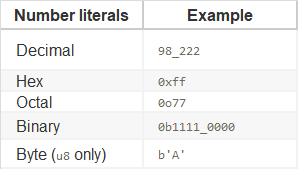2.2 数据类型
2
2
Rust has four primary scalar types: integers, floating-point numbers, Booleans, and characters.
整数类型

2
3
4
2
3Additionally, the isize and usize types depend on the kind of computer your program is running on: 64 bits if you’re on a 64-bit architecture and 32 bits if you’re on a 32-bit architecture.
4

Note that all number literals except the byte literal allow a type suffix, such as 57u8, and _ as a visual separator, such as 1_000.
整数溢出
2
3
4
2
3In release builds, Rust does not check for overflow, and instead will do something called “two’s complement wrapping.” In short, 256 becomes 0, 257 becomes 1, etc. Relying on overflow is considered an error, even if this behavior happens. If you want this behavior explicitly, the standard library has a type, Wrapping, that provides it explicitly.
4
浮点类型
Rust’s floating-point types are
f32
and
f64, which are 32 bits and 64 bits in size, respectively. The default type is
f64
because on modern CPUs it’s roughly the same speed as
f32
but is capable of more precision.
2
3
4
5
6
2 let x = 64.0 ; //f64
3 let y: f32 = 32.0; //f32
4 println!("64:{},32:{}",x,y);
5}
6
2
2
数字运算
2
3
4
5
6
7
8
9
10
11
12
13
14
15
16
17
18
19
20
21
2 // addition
3 let _sum = 5 + 10;
4
5 // subtraction
6 let _difference = 95.5 - 4.3;
7
8 // multiplication
9 let _product = 4 * 30;
10
11 // division
12 let _quotient = 56.7 / 32.2; //1.7608695652173911 小数点后16位
13 let _ff32 = 7f32 / 3f32; //2.3333333 7位小数
14
15 // remainder
16 let _remainder = 13 % 5; //3
17 println!{"32位除法:{}",_ff32}
18 println!{"默认64位除法:{}",_quotient};
19 println!{"求余:{}",_remainder};
20}
21
整数与浮点数不可以混合运算,比如 let _cc = 10 * 3.0; 会报以下错误
^ no implementation for
1 | 1` |
{integer} * {float}
1 | 1` |
error: Could not compile
1 | 1` |
datatype
1 | 1` |
.
布尔类型
2
3
4
5
2 let _t = true;
3 let _f: bool = false; // with explicit type annotation
4}
5
字符类型
2
3
4
5
6
2 let _a = 'z';
3 let _b = 'ℤ';
4 let _c = 'Z';
5}
6
2
2
复合类型
Compound types
can group multiple values into one type. Rust has two primitive compound types: tuples and arrays.
元组
A tuple is a general way of grouping together some number of other values with a variety of types into one compound type. Tuples have a fixed length: once declared, they cannot grow or shrink in size.
Each position in the tuple has a type, and the types of the different values in the tuple don’t have to be the same.
2
3
4
5
6
7
2 let _tup: (i32, f64, u8) = (500, 6.4, 1);
3 let _aa = (1,2.3,"wa ka ka ");
4 let (_x,_y,_z) = _aa;
5 println!("The value of z is:{}",_z)
6}
7
2
3
4
2
3 In addition to destructuring through pattern matching, we can access a tuple element directly by using a period (.) followed by the index of the value we want to access.
4
2
3
4
5
6
7
8
2 let _x: (i32, f64, u8) = (500, 6.4, 1);
3 let _five_hundred = _x.0;
4 let _six_point_four =_x.1;
5 let _one = _x.2;
6 println!("第三个元素:{}",_one);
7}
8
数组类型
Unlike a tuple, every element of an array must have the same type. Arrays in Rust are different from arrays in some other languages because arrays in Rust have a fixed length, like tuples.
2
3
4
2 let _a = [1, 2, 3, 4, 5];
3}
4
Arrays are useful when you want your data allocated on the stack rather than the heap or when you want to ensure you always have a fixed number of elements. An array isn’t as flexible as the vector type, though. A vector is a similar collection type provided by the standard library that is allowed to grow or shrink in size. If you’re unsure whether to use an array or a vector, you should probably use a vector.
It’s very unlikely that such a program will need to add or remove months, so you can use an array because you know it will always contain 12 items
2
3
4
5
6
2 let _a = [1, 2, 3, 4, 5];
3 let _months = ["January", "February", "March", "April", "May", "June", "July",
4 "August", "September", "October", "November", "December"];
5}
6
Arrays have an interesting type; it looks like this: [type; number]. For example:
2
3
4
2 let _b: [i32; 5] = [1, 2, 3, 4, 5];
3}
4
访问数组元素
2
3
4
5
6
2 let _b: [i32; 5] = [1, 2, 3, 4, 5];
3 let _c1 = _b[0];
4 let _c2 = _b[1];
5}
6
数组越界
2
3
4
5
6
7
8
9
2 let a = [1, 2, 3, 4, 5];
3 let index = 10;
4
5 let element = a[index];
6
7 println!("The value of element is: {}", element);
8}
9
编译阶段不会报错,在运行时会报错
2
3
4
5
6
7
8
9
2 Compiling datatype v0.1.0 (/usr/local/automng/src/rust/test/datatype)
3 Finished dev [unoptimized + debuginfo] target(s) in 1.39s
4[root@itoracle src]# cargo run
5 Finished dev [unoptimized + debuginfo] target(s) in 0.01s
6 Running `/usr/local/automng/src/rust/test/datatype/target/debug/datatype`
7thread 'main' panicked at 'index out of bounds: the len is 5 but the index is 10', src/main.rs:5:19
8note: Run with `RUST_BACKTRACE=1` for a backtrace.
9
